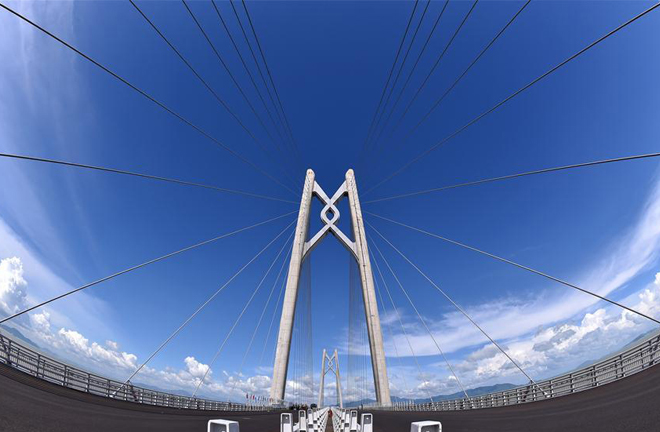Innovation drives construction of Guangdong-Hong Kong-Macao Greater Bay Area

The photo shows a section of the Hong Kong-Zhuhai-Macao Bridge as seen on July 5, 2017. Getting closer to an official opening, the bridge will be the world's longest sea bridge and facilitate development of the Guangdong-Hong Kong-Macao Greater Bay Area. (XINHUA)
GUANGZHOU—At a seminar on March 30, experts voiced support for transforming the Guangdong-Hong Kong-Macao Greater Bay Area into a world-class center of innovation.
“According to the relevant indices, the R&D investment in the Guangdong-Hong Kong-Macao Greater Bay Area in 2016 accounted for a greater share of the regional GDP relative to emerging economies as well as Singapore and South Korea, among others, and began to approach and even exceed that of the United States, Japan and Europe,” said Yang Mu, executive director of the Institute of Public Policy at South China University of Technology. The area already possesses some prerequisites for the construction of innovation highlands, he said.
Yang said the area is not only at the forefront of invention patents for China but also home to a wide variety of agencies for innovation. Universities in Hong Kong are strong while Sun Yat-sen University, South China University of Technology and other universities in Guangdong have also undergone rapid and sound development. Over the years, they have well integrated production, education and research, he added.
The construction of the Guangdong-Hong Kong-Macao Greater Bay Area is a new model of regional governance under the principle of “one country, two systems” and the result of active exploration of innovation-driven and economic transformation, market systems and resource allocation, said Han Dongxue, a professor from the School of Marxism at Tsinghua University. The area will be an active player in national reforms and innovations, providing valuable practical experience for China’s regional economic restructuring, he said.
Wei Houkai, director of the Rural Development Institute at the Chinese Academy of Social Sciences, suggested the area should rely on the full-scale opening up and innovation to deepen cooperation among Guangdong, Hong Kong and Macao. It is necessary to fully realize the leading role of the core cities, strengthen the division of labor and cooperation among cities, and strive to build a high-quality, world-class urban agglomeration with coordinated production, living environment and ecology suitable for life, work and tourism. In addition, it is necessary to strengthen both urbanization and rural vitalization and accelerate the transformation of industrialization and urbanization.
“Guangzhou must strengthen the construction of a national central city, take the core functions of a global city as the guideline, and serve as a comprehensive hub in the construction of the area,” said Dong Xiaolin, former vice-president of Guangdong University of Foreign Studies. He said that Guangzhou needs to build upon the world-class urban agglomeration in the area while joining hands with internationally remarkable central cities to develop a high-end group of cities with exchanges between each other in the world.
“Currently, the Guangdong-Hong Kong-Macao Greater Bay Area needs to solve the problems in cooperation and development, and deal with the complexity of the entire external economic and political environment,” said Zeng Weiyu, president of Guangzhou Association of Social Science Societies. The area has reached a world-class economic scale with relatively complete infrastructure and good economic conditions. However, from the perspective of social operating mechanisms, the question of how to promote the successful integration and development of the area requires in-depth research from academics and think tanks, Zeng said.
The construction of the area needs to be driven by innovation, Wei said. “The innovation of the Guangdong-Hong Kong-Macao Greater Bay Area is not a simple issue of technological innovation. There should be a comprehensive promotion of technological, institutional, management and brand innovation. The Pearl River Delta’s institutional innovation did well in the past, but there is still a lot of work to be done in scientific and technological innovation, management innovation, and in particular, brand innovation.”
LI YONGJIE is a correspondent with Chinese Social Sciences Today.
(edited by JIANG HONG)
